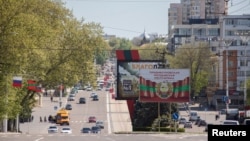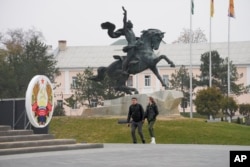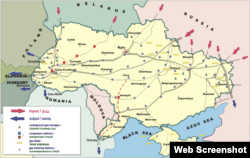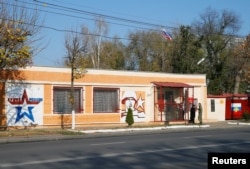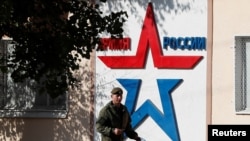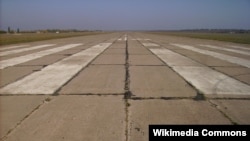Russia’s desire to create a land corridor to Moldova’s separatist region of Transnistria is drawing attention to Moscow's efforts to prevent the pro-Russian enclave from deepening ties to the West and undermining the decadeslong Russian grip over part of Moldova, some analysts say.
Russian General Rustam Minnekaev endorsed the idea of a land corridor on April 22, saying: “Control over the south of Ukraine is another way to [reach] Transnistria,” according to Russian news agency Interfax. He said Transnistria’s Russian-speaking population suffers “oppression,” implying that it needs Russia’s protection from Romanian-speakers in the rest of Moldova.
Moscow has made similar assertions about Russian speakers in Ukraine to justify its invasions of Ukrainian territory since 2014.
Transnistria is a majority Russian-speaking territory that broke away from Moldova in 1990, a year before the majority Romanian-speaking Soviet republic declared independence from the Soviet Union. A 1992 war between Moldovan forces and Transnistrian separatists backed by Russian troops ended with a cease-fire that has remained in effect for 30 years, leaving Transnistria to run its own affairs as a de facto state but without international recognition.
Russia has not recognized the region as a state. But it has helped the separatists for decades to administer a sliver of land on Moldova’s eastern edge, between the east bank of the Dniester River and the Ukrainian border. Transnistria has a population of 300,000 to 400,000 according to Moldovan and separatist estimates, respectively.
Russia’s support for the separatist region has prolonged what some observers call a “frozen conflict” that has kept Moldova too weak to join major Western institutions. Moscow has long regarded the expansion of the NATO alliance and European Union into post-Soviet states such as Moldova as a threat to its security.
Moscow’s main support for Transnistria has taken the form of providing it with free Russian natural gas, a presence of about 1,500 Russian troops and bank transfers of Russian funds.
But Transnistria has been reorienting its trade toward the EU since the bloc signed a free trade agreement with Moldova in 2014. That deal granted the enclave tariff-free exports to the EU under certain rules and visa-free travel to the EU for residents with Moldovan passports.
As the separatists’ trade with the EU rose in recent years, their trade with Russia declined.
Former U.S. ambassador to Moldova Asif Chaudhry told VOA Russian that the 2014 agreement has opened people's minds on the Transnistrian side. “They see that it is to their economic and personal benefit to have a better relationship with the Republic of Moldova,” he said.
One way Russia has tried to counter that trend is by providing the separatist region with free natural gas from Moscow-controlled energy company Gazprom through pipelines crossing Ukrainian territory.
Transnistria, which is poor in natural resources, uses the gas to produce electricity and metal products that it sells to customers in similarly resource-poor Moldova and to foreign customers at market prices, according to Moldovan energy analyst Sergiu Tofilat, who served as an energy adviser to Moldova’s president from 2020 to 2021.
Speaking to VOA Ukrainian from Moldova, Tofilat said separatist authorities relied on income from natural gas-derived products for 53% of their budgetary spending in 2019 and for 40% in 2020.
In a study he published in 2020, Tofilat also found that the value of the Russian gas obtained by Transnistria was equivalent to 48% of its gross domestic product from 2007 to 2016.
“Half of the Transnistrian economy survives only due to the gas subsidy from Russia,” he told VOA.
Russia also maintains influence over the enclave with a deployment of about 1,500 troops, said former Moldovan defense minister Vitalie Marinutsa, who served in the role from 2009 to 2014. He spoke to VOA Russian in Moldova on May 3.
Several hundred of those Russian troops serve under the authority of a peacekeeping force known as a Joint Control Commission that also includes Moldovan and separatist personnel. The rest of the Russian contingent guards a major depot of Soviet-era ammunition near the village of Cobasna and trains separatist paramilitaries.
Another tool of Russian influence is the use of banks to wire Russian funds to the separatist region.
Tatsiana Kulakevich, a Russia researcher at the University of South Florida, told VOA that Moscow wires the funds to the separatist government owned Transnistrian Sberbank to provide pensions to residents. Transnistrian Sberbank is part of the correspondent network of Russia’s largest bank, also named Sberbank.
Kulakevich said she does not see any threat to Russia’s ability to transfer money to the separatist region, as Moscow has been using its own network to facilitate transactions and shield itself from Western sanctions targeting Russian banks’ use of the SWIFT international financial messaging system.
But Russia’s policy of making Transnistria dependent on it for free natural gas to generate electricity could create problems for the enclave in the coming years, as Moldova looks to reduce its own dependence on that electricity, Tofilat said.
“Moldova’s government has decided to construct a high-voltage power line that will connect us with Romania and diversify our electricity supplies. This will take another three years,” he said.
Russia also faces difficulties in keeping its military presence in the separatist region supplied with personnel and weapons.
Since Russia annexed Ukraine’s Crimean Peninsula and invaded its eastern Donbas region in 2014, Ukrainian authorities have cracked down on Russian smuggling of people and arms into Transnistria, whose border with Ukraine is porous, Kulakevich said.
“News reports suggest the Ukrainians are better guarding the border, but it’s hard to control completely,” she said.
Moldova also has tried to block Russia from sending military personnel to the separatist region through Moldovan government-controlled territory.
“We have taken steps to ensure that this military exchange [of personnel] does not take place,” said Anatol Salaru, a former Moldovan defense minister who served from 2015 to 2016, in an interview with VOA sister TV network Current Time last month.
Russia also has no simple way to supply its forces in Transnistria by air. The enclave’s only airfield, a former Soviet military base near its self-styled capital Tiraspol, has not been in operation for more than 30 years, according an April 27 article by Ukrainian news site European Pravda.
Ukrainian national news agency Ukrinform reported on April 6 that authorities in Tiraspol were preparing the airfield to receive aircraft. It did not elaborate on whether the preparations were for military or civilian flights.
One of the shortest paths for Russian aircraft to reach Tiraspol would be to fly from one of the airfields in Russian-occupied Crimea over the Black Sea toward the separatist region. But that would entail flying through at least 40 kilometers of Ukrainian airspace.
Sergey Bratchuk, a spokesman for Ukrainian military forces in the Odesa region bordering Transnistria, said in an April 30 Telegram post that they had received new air defense systems to use against Russia.
Speaking earlier this week, as reported by the BBC, Bratchuk had this warning for Russian aircraft attempting the journey to Tiraspol: "We have the right to shoot them down over the territory of Ukraine. These are enemy planes [attempting] enemy landings.”
Alex Yanevskyy reported from Moldova.




